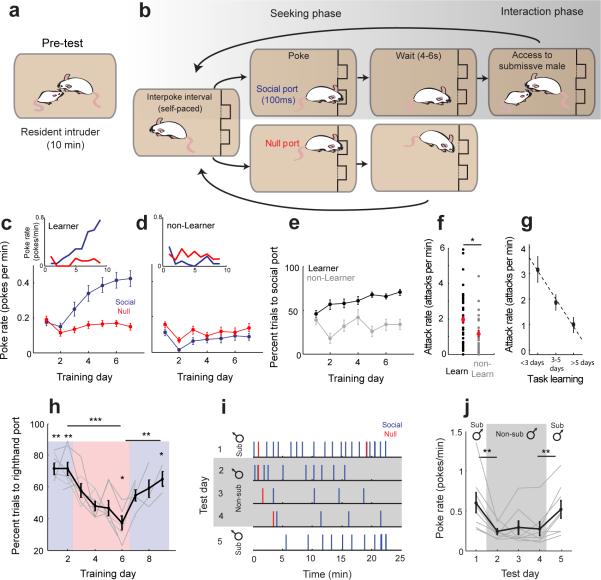Figure 1.
Male mice will seek opportunities to attack in the absence of threat-provoking cues. (a-b) Mice were screened for aggression using the resident-intruder paradigm (a) and then trained on the self-initiated aggression task (b) which separates the aggression seeking phase from the social interaction. (c-d) Average learning curves for all “learners” (c, N = 43/76 mice) show increased response rates for the social port (blue) across training while “non-learners” (d, N = 33/76 mice) show no increase relative to the null port (red). Insets show behavior of example learner and non-learner individuals. (e) Percent trials to social port increases for learners (black) relative to non-learners (gray) across training. (f) Learner males exhibited more aggression during the resident intruder test than non-learner males (t(67) = 2.201, *p = 0.031, unpaired t-test). (g) Comparison of aggression level exhibited during resident intruder test to speed of task learning (N = 39 learners). (h) Behavioral reversal when contingency is reversed. Blue and red show testing days where righthand and lefthand ports respectively were associated with the submissive male reinforcement (Comparison of final days of reversal, t(6) = 13.3315, ***p = 1.102×10−5; t(6) = −4.447, **p = 0.004, paired t-test. Single day comparisons for Day1: t(6) = 5.900, **p = 0.001; Day 2: t(6) = 5.077, **p = 0.002; Day 6: t(6) = −3.392, *p = 0.015; Day 9: t(6) = 2.818, *p = 0.030; t-test, N = 7 mice). (i) Behavior of a representative animal (1 of 8) during the non-submissive replacement test. Each tick represents one nosepoke. (j) Response rate across animals is reduced for a non-submissive male (t(7) = 3.548, **p = 0.009, paired t-test, N = 8 mice), and response rate recovers when access to a submissive male is resumed (t(7) = −4.167, **p = 0.004,, paired t-test, N = 8). c-h,j show mean ± s.e.m.

